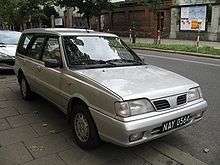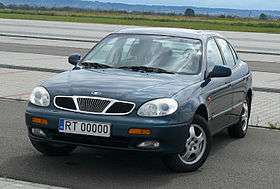Fabryka Samochodów Osobowych
 | |
|
Main gate of FSO in Warsaw | |
| Joint stock company | |
| Industry | Automotive |
| Fate | closed |
| Founded | 6 November 1951 |
| Defunct | 2011 |
| Headquarters | Warsaw, Poland |
Area served | Worldwide |
Key people | Janusz Woźniak (Chairman) |
| Products | Automobiles |
| Revenue |
|
|
| |
|
| |
| Parent | UkrAVTO |
| Website | fso-sa.com.pl |
Fabryka Samochodów Osobowych (English: Passenger Automobile Factory), commonly known as FSO, was a Polish automobile manufacturer, located in Warsaw. The company ceased to exist in March 2011. By November 2011 the former assembly buildings were dismantled and the factory test track was sold for other use.
Early history

The FSO plant was established in 1951 by the Communist Polish government in Żerań on Warsaw's eastern bank of the river Vistula, to produce automobiles for post World War II Poland. The first FSO car was the Warszawa, manufactured under the Soviet GAZ-M20 Pobeda licence.
In 1953, an in-house team started development of a smaller, popular car, resulting in the second FSO model, a two-stroke Syrena, introduced in 1957. The Syrena was a proprietary design of FSO; its production was next moved to FSM car factory (Fabryka Samochodów Małolitrażowych).
Polski Fiat and Polonez era

In 1965, the Polish government signed license agreements with the Italian auto manufacturer Fiat to manufacture selected Fiat models in Poland, under the brand Polski Fiat. In particular, the Fiat 125 was to be manufactured at FSO to replace the outdated Warszawa. The resulting model, called Polski Fiat 125p, was in fact a simplified model with Fiat 1300/1500 mechanicals, and was exported for some time under the names Fiat 125p and later, after the license agreement ended, FSO 1300/1500. It was also produced in estate car and pick-up variants. Meanwhile, the Warszawa was manufactured concurrently until 1973.
In 1978, FSO introduced a new model, called Polonez, a 5-door compact car based on updated FSO 1500 design. The Polonez was also exported to many markets under the FSO brand. This model was initially to substitute all variations of the original 1500, but actually the production of the latter lasted until 1991, and both models were updated a few times during that period.

The Fiat Polski 125P was produced until 26 June 1991. In total, 1,445,689 were manufactured. By that time the design was 24 years old and used mechanicals which were essentially 30 years old, with only minor improvements.
Daewoo era
After the end of the Cold War and the Iron Curtain with the Fall of Communism in Poland, and in the rest of Warsaw Pact Eastern Europe in 1989, the Polish government sought to privatise FSO by establishing a partnership with an international automaker to secure its future. Despite many attempts and negotiations, this was not the case for many years. The first full-fledged venture started in 1994, when an agreement with General Motors was signed to assemble Opel Astra in Żerań. Nevertheless, the following year FSO was sold to the Korean Daewoo Motors, which was at that time a competitor of GM. The company was then renamed Daewoo-FSO.
At first, Daewoo used FSO to assemble models such as Daewoo Tico and Daewoo Espero. In 1997, the assembly and then full-fledged production of Daewoo Lanos commenced, followed in 1999 by the Daewoo Matiz. Other contemporary Daewoo models like Nubira, Leganza, Korando, Musso or Chairman were also assembled. The production of Polonez was maintained, the model was modernized and new body styles were added. Nevertheless, waning demand led FSO to cease Polonez production in 2002.
Meanwhile, General Motors decided to build their own factory in Poland, in Gliwice, where the production of Opel Astra was relocated in 1998. GM's assembly line at FSO was then used for a short time to assemble Opel Vectra for the local market and then shut down completely, ending the relationship with General Motors.
Post-Daewoo FSO

Daewoo went bankrupt in 2000 leading to an acute deterioration of FSO's position in the industry. Daewoo Motors was bought out by General Motors (and its Asian partners), but overseas manufacturing subsidiaries such as Daewoo-FSO were not part of the deal. Therefore, FSO became de facto independent again.
Through lengthy negotiations, the Polish government secured FSO the rights to manufacture and sell the Lanos and the Matiz until 2007. Nevertheless, FSO did not have the means to update the models, so they quickly became less and less attractive. Additionally, Daewoo's collapse caused buyers to become wary of Daewoo cars. FSO found salvation in the Ukrainian market, where Matiz and Lanos, assembled by the local partner AvtoZAZ, became very popular. In 2004, Daewoo-FSO was renamed FSO again.
During that period, the Polish government was actively seeking a new strategic partner for FSO, but no major automaker expressed interest. Finally, FSO entered talks with the British MG Rover, but as talks progressed it became apparent that the British company did not have the means to complete the deal despite suggestions of the involvement of an (alternating) Chinese partner. MG Rover went into administration in 2005, putting an end to any hopes connected with it.
Consequently, the UkrAVTO, the owner of ZAZ, became the only possible partner for FSO. The Ukrainian company gradually became a majority shareholder of FSO (84.31% of shares), while at the same time strengthening the cooperation between FSO and ZAZ. UkrAVTO suggested it will provide a new model for the FSO to manufacture after the Matiz and Lanos licenses expire.
In mid-2006 the parent company of FSO, UkrAVTO, signed a license agreement with General Motors to produce the Chevrolet Aveo (T250) saloon, and since July 2008, the 3 and 5-door hatchback. For the production of the Aveo a new company was formed, whose shareholders were FSO (60%) and GM (40%); FSO provided the plant, while GM provided the finances. The first Aveo rolled off the FSO plant on 11 July 2007.
The 100,000th Aveo rolled off the assembly lines on February 1, 2011. The license for the production of Aveo expired in February 2011 and it was not resumed for the next generation model. By March 2011 more than 1,800 employees were made redundant and the land on which the factory was built was offered for sale. By November 2011 the foundry and engine assembly building were demolished and the factory test track was also sold for other use.
Production history
- Warszawa 254,471
- Syrena 177,234
- Polish Fiat 125p 125p/FSO 1,445,699
- Polonez 1,061,807
- Daewoo Tico 126,369
- Daewoo Espero 20,573
- Daewoo Nubira 33,116
- Daewoo Tacuma 427
- Daewoo Leganza 3,969
- Daewoo Lanos / FSO Lanos 165,272 ¹/ ¹ to October 2001
- Daewoo Matiz / FSO Matiz 126,469 ¹/ ¹ to October 2001
- Chevrolet Aveo 150,000
- Cars assembled in FSO 73,376
- Special-12 800
History of unrealized projects
- 1959 – Van sirens project, the world's first car with body Van
- 1960 – creation of Siren Sport, one of the few Polish post-war sports cars
- 1961 – Sirens laminate prototypes, the modern successor of Sirens 104
- 1964 – Warsaw prototype 210
- 1966 – Siren 110 prototypes, the first hatchback in the world
- 1971 – Polish Fiat 125p Coupe
- 1974 – 1100 Coupe FSO
- 1974 – Polish Fiat 125p convertible
- 1977 – Hound, sports car
- 1981 – Polonaise Pick-up 3-axis, with center-wheel drive
- 1982 – Polonez Sedan, based on the model 1300/1500
- 1982 – Polonaise Long, 7-door saloon was also on the model 1300/1500
- 1985 – Wars, a modern family car
- 1994 – FSO Polonez Analog
See also
External links
| Wikimedia Commons has media related to FSO vehicles. |
- Official FSO page (pl)
- The Story of FSO Warszawa (ru)
- The Unofficial FSO pages (archived)
- Aveo and Lanos production lines (ukr)
- The First Official FSO Club outside from Poland (multilang)